Pteriomorph bivalves (Subclass Pteriomorphia) are bivalves with taxodont (with a few reduced teeth or no teeth) hinges. They have elaborate, folded leaf-like gills used for both respiration and feeding. Some have a nacreous shell interior, while others may have a porcelaneous interior. Many pteriomorphs are sessile, living attached to rocks and other hard structures. Others may be free-living or shallow burrowers. They may have a short siphon, or no siphon at all. The foot and anterior adductor may be very reduced or lost in many species.
Here are some of the pteriomorphs that I have photographed and identified on our shores so far (thanks to Siong Kiat who gave tips on how to identify them!). You may want to take a look at the diagram below if you are not familiar with the names of the parts, so as to better understand the terms used.
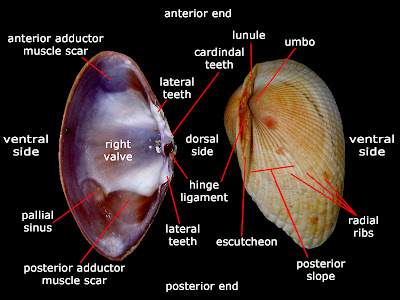
Family Arcidae
Bivalves from the family Arcidae, usually called arkshells, are characterised by their hooked umbones and straight-edged hinge with a series of small comb-like teeth. The ligament is external, and many have byssal threads to anchor themselves to hard substrates. The shapes tend to appear somewhat rectangular, and the surface is marked with radial ribs and often covered with hair-like structures. In the shell interior, two subequal adductor muscle scars and a pallial line without a sinus can be seen. Interestingly, they have hemoglobin, an oxygen transport pigment, dissolved in both the blood and tissues, colouring the animal reddish. This is unlike most other bivalves, which absorbs oxygen directly from the water into the tissues. In Singapore, they are often mistaken and wrongly identified as cockles, which are from the family Cardiidae, as both families possess radial ribs. The "See Hum" which is well-loved by Singaporeans, either boiled or added to laksa and char kuay teow, is actually an arkshell, but often called "Blood Cockles" in Singapore.

The Antique Arkshell (Anadara antiquata) is usually found on muddy substrates. It has about 35-44 radial ribs that are at most slightly granulated. The shell is greyish white, often stained darker grey around the umbones. It is widely collected for food. It can grow to about 7-10cm long.
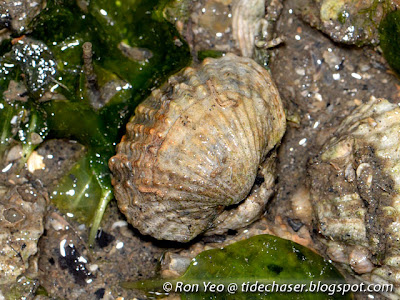
The Granular Arkshell (Anadara granosa), also called Blood Cockle or See Hum in Singapore, has thick and solid shells that are strongly inflated.The umbones are large and strongly protruding. It has about 15 to 20 radial ribs which are widely spaced apart on each valve, and the ribs are stout and distinctly marked with somewhat rectangular nodules. It is widely collected for food, and well-loved by Singaporeans, either boiled or added to local dishes such as laksa and char kuay teow. It can grow up to 9cm long, but the ones in the market are usually less than 5cm.

The Almond Arkshell (Barbatia amygdalumtostum) is commonly found under rocks. The shell is dark brown with a few pale bands radiating from the umbones. It generally has a hairy appearance, and can grow to about 5cm long.
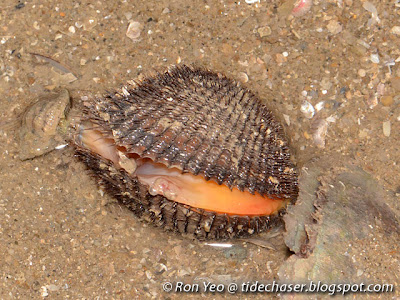
I often saw this unknown arkshell during my trips, but unfortunately did not collect it to confirm the species.
Family Pectinidae
Members from the family Pectinidae, or scallops, generally have fan-shaped shells with two fin-like extensions (anterior and posterior ears) at the hinge, one on each side of the "fan", hence forming a straight and extended line at the hinge. The surface is marked with radial ribs. They have a powerful adductor muscle, a toothless hinge with a socket-like arrangement and the ligament is mostly internal. They only have the posterior adductor muscle scar, and have a pallial line but no sinus. Their foot is greatly reduced, and they do not have siphons. To feed, they clap their valves to generate a current so as to filter plankton from the water. Scallops possess tiny but well-developed eyes along the edge of their fleshy mantle. They are able to produce byssus to anchor themselves to hard surfaces, but most species will cast off their byssus as they mature and become free-living. Some species are able to swim by clapping their valves to expel water around the hinge, hence propelling them in the direction of the valve opening. Many scallops are collected for food, and most of the time, only the huge adductor muscle is eaten.

The Singapore Scallop (Volachlamys singaporina) is commonly encountered attached to hard structures (such as another shell) on sandy substrates, especially among seagrass. The shell is relatively small (up to 6 cm long), with 20 to 23 radial ribs on each valve. The anterior ear (on the right in the above photo, but on the left in the below photo) is much longer than the posterior ear.

Sometimes, Singapore Scallops can be found lying freely among seagrasses or on sandy substrates too. The gap between the anterior ear and the main valves, called the byssal notch, is relatively deep.

The Flatribbed Scallop (Comptopallium radula) is commonly found in reef flats, either free-living or attached to hard substrates like rocks and corals. It has about nine to thirteen radial ribs on each valve, with numerous, much smaller, secondary radial riblets. The dorsal ears are somewhat equal-sized. It is collected for food in areas where it is abundant.

A closer look at the opening of the valves of the Flatribbed Scallop reveals lots of short tentacles. The Flatribbed Scallop can grow up to about 9cm.

This Coral Scallop (Coralichlamys madreporarum) is usually found attached to corals, and usually does not exceed a length of 3cm.
Family Limidae
Closely related to the scallops, the file clams of the Limidae family are also fan-shaped, but lacks the fin-like extensions. They only have the posterior adductor muscle scar, and a pallial line but no sinus. The foot can range from short and thick to long and narrow. Most species remain attached to the substrates with byssal threads or hide under rocks, though several are known to be free-living. Some species can swim by clapping their valves, much like the scallops, but instead of moving in the direction of the valve opening, they usually go in the direction of the hinge. They possess long sticky tentacles, which can be vibrantly coloured and break off easily to confuse predators. The shell surface is usually very rough, and hence the common name "file clam".
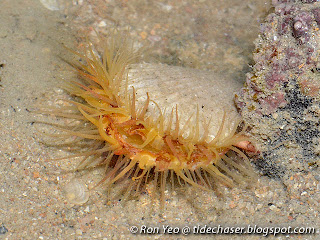
The Common File Clam (Lima vulgaris) is usually found attached to rocks or corals or as free-living individuals (which can swim actively). The shell is thick and marked with radial sculpture of coarse scaly ribs. It usually does not exceed 9cm in length.

Like most Lima species, the Common File Clam can close its valves completely.

The Fragile File Clam (Limaria fragilis) is usually found under rocks or in crevices, though it can actively swim. The sticky tentacles break off easily to distract predators. Like most other Limaria species, it cannot close its valves completely. The shell can grow to about 5cm long.

This unknown Limaria sp. was seen once under a rock on St John's Island.
Family Pinnidae
Bivalves from the family Pinnidae are usually called pen shells (for their pointed tips) or fan shells (for the shell's fan-like or narrowly triangular shape). The shell is very thin and fragile, the hinge is toothless. The interior of the shell has a thin pearly layer towards the anterior half of the valves. The two adductor muscle scars are unequal, with the anterior one relatively small. There is no pallial sinus. The foot is long, conical and grooved. It has no siphon. These bivalves are usually half-buried in the sand/mud, anchored to their position by numerous byssal threads. The byssal threads of some pen shells are in fact used to weave into sea silk, a very valuable fabric which is extremely light and warm. Species found in the region are often collected for food.

The Bicolor Pen Shell (Pinna bicolor) is often seen embedded in muddy sand and reef flats. They can grow to over 40cm long, and are often collected by locals for food.

Here's a look at the fleshy part of the Bicolor Pen Shell from the top.

Many pen shell (or fan shell) species are covered with sediment or encrusting organisms, and it can be a challenged trying to identify them.
Family Placunidae
Members of this family are often called "window pane shells", as they are collected, polished, and pasted together to make into window panes or lamp shades in the region. The shells are very much flattened, and have a pearly surface. The hinge is almost straight with no teeth and no byssus. The ligament is usually internal, forming an inverted V-shaped structure. The shells have a single, centrally located posterior adductor muscle scar, and no pallial sinus. The foot is long, narrow and cylindrical.

The Windowpane Shell (Placuna placenta) has thin, rounded shells which are almost translucent. It is often found on sandy or sandy-muddy substrates in sheltered coasts without strong waves, sometimes just beneath a thin layer of sand/mud. They are often collected or commercially cultured for their shells, which are used to make window panes and shellcraft. The soft parts are eaten by the locals. It can grow to over 15 cm long.

The Saddle Windowpane Shell (Placuna ephippium) is somewhat rectangular and saddle-shaped, i.e. the shell bends a little, forming a slight arch like the saddle of a horse. It can grow to over 20cm long, and is collected for good and making shellcraft.
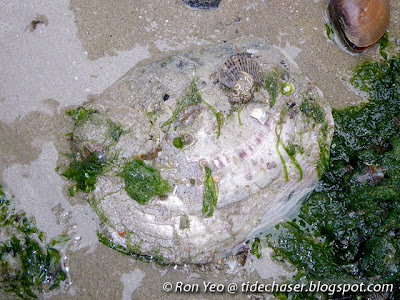
Saddle Windowpane Shells can be found in areas with sandy-muddy substrates, and sometimes other sessile organisms can be seen growing attached to it, such as the scallop seen attached to the one above.
Family Anomiidae
Anomiid bivalves, or jingle shells, usually have very thin and somewhat flattened shells. They are usually attached to rocks, shell fragments, or even mangrove trees with their large and calcified byssus. There is a large and deep notch for the byssus in the lower valve near the hinge. The foot is dwarfed, finger-like, and grooved. Most shells have very pretty, pearly surfaces, and are hence collected for shellcraft.

The Mangrove Jingle Shell (Enigmonia aenigmatica) is usually found attached to the leaves of trees in the mangroves, appearing like scales on the leaves.

Sometimes, Mangrove Jingle Shells can also be seen growing on pillars and other man-made structures in the mangroves. Interestingly, while they are usually more yellowish while growing on leaves, they turned purplish brown when they are growing on man-made structures. This animal is known to be motile and move from place to place.
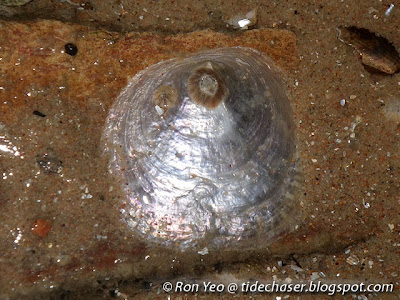
This unidentified jingle shell is attached to a rock fragment.

This is another unidentified jingle shell of a brownish coloration that is attached to the shell of a dead bivalve.
Family Malleidae
Most species from this family are called "hammer oysters", as the shells often appear "T"-shaped, though there are many exceptions. The hinge is narrow and held by an oblique ligament rather than teeth, and the shell is partially nacreous. The umbones are not conspicuous. The interior of each valve only has the posterior adductor muscle scar, and a pallial line without a sinus. The adults may or may not have byssal threads. The foot is divided into two unequal parts. They do not have a siphon. They can be free-living, partially buried in sandy substrates, or attached to hard substrates, or embedded in sponges.
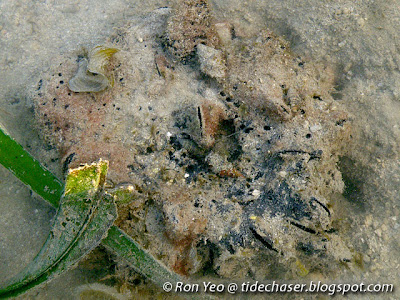
The Sponge Finger Oyster (Vulsella vulsella) is usually found embedded in sponges. It has lost the dorsal ears found in most hammer oyster species. Only the ventral opening protrudes out of the sponge for filter feeding, appearing like fingers poking out. They can grow to over 6cm long.

The White Hammer Oyster (Malleus albus) can be found on sandy or muddy-sandy bottoms, anchored to the substrate by the long and narrow extensions (or ears) of the dorsal margin. It can grow to over 20cm long, and is collect for food in the region.
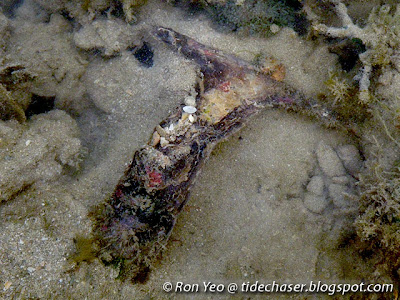
The Black Hammer Oyster (Malleus malleus) is more commonly found on reef flats and seagrass areas, either attached to hard structures like rocks and dead corals, or living freely, partially buried in the sediment and using the long dorsal ears as an anchor. It is collected for food, and the shell is used to make lime or shellcraft. It can grow to over 20cm long.

The Straight Hammer Oyster (Malleus regula) has very short dorsal ears (mostly only on one side), or none at all. It is normally attached to hard structures on reef flats or rocky shores near mangroves, usually in areas with some sedimentation.

The Straight Hammer Oyster can grow to over 10cm long. It can be easily confused with other similar-looking sessile clams, but can be differentiated by the presence of a beak around the middle of the dorsal margin, and less obvious growth lines.
Family Pteriidae
Bivalves from this family generally have somewhat compressed shells and a straight dorsal margin, with a wing-like ear on each or both ends. Members previously group under the family Isognomonidae (commonly called "leaf oysters") are recently included under this family after phylogenetic studies. The left valve of the shell is usually a little more inflated than the right valve, and there is a strong byssal notch anteriorly. The exterior surface of the shell often appears scaly or lamellate. The umbones are small, and the hinge is narrow and usually toothless. The interior of the shell is usually nacreous, with one large posterior adductor muscle scar and a pallial line but no sinus. The foot is small and grooved, with a strong byssus. They do not have any siphon. Many pearl oysters are from this family, and they have been exploited since ancient times for their ability to produce pearls. Some species may be confused with members of the previous family.

The Pacific Toothed Oyster (Isognomon isognomon) is commonly found in the same area as the Straight Hammer Oyster, and it can be quite a challenge to differentiate them in the field, unless the dorsal margin is not covered by encrusting organisms. They are attached to hard substrates, sometimes in dense colonies. Most have a longer dorsal ear compared to the previous species, and the beak is position more to one side of the dorsal margin. It can be differentiated by the flaky shell exterior composed of layers of plate-like structures as well.

Also, the external ligament is set in a series of transverse grooves along the dorsal margin, giving it the "zebra-crossing" appearance. It can grow to more than 10cm long.

The Mangrove Tree Oyster (Isognomon ephippium) is usually found attached to mangrove trees or rocks near mangroves. It is usually very abundant in areas with muddy brackish water, where dense populations can be found attached to the roots of mangrove trees.

The Mangrove Tree Oyster can grow to about 10cm long, with an irregularly rounded outline. Like other tree oysters, it has a flaky shell exterior, composed of layers of plate-like structures.

Pod Tree Oysters (Isognomon legumen) are commonly found byssally attached to the undersides of rocks in intertidal areas, sometimes forming dense populations. They have whitish shells that are irregularly shaped, but exhibit the same flaky surface with layers of plate-like structures forming the shell exterior.

This unknown tree oyster was found under a rock as well, but the coloration is not typical of Isognomon legumen, so I am not really sure if it is the same species.

Pearl Oysters (Pinctada spp.) can also be found in local waters. They are usually attached to rocks and dead corals.

Winged Oysters (Pteria spp.) are usually seen attached to sea fans or hydroids. The shell exhibit a wing-like appearance. Some species are known to produce pearls.
Family Mytilidae
Members of this family are usually called "mussels". They generally have pear-shaped shells, and are attached to the substrates with strong byssus. Most are found on rocky and other hard substrates, but some have adapted to living in sandy or muddy substrates as well, with some species building nest covering huge areas of shallow sea beds. The hinge has no or reduced teeth, and the ligament is long and external. The interior of the shell is pearly. The anterior adductor muscle scar is small or sometimes absent in the adult, while the posterior adductor scar is large. The shell has a pallial line but no sinus. The foot is long and grooved. The siphons are either very reduced or absent. Many species are economically important, being edible and abundant.

Asian Green Mussels (Perna viridis) are very commonly in local waters, usually found attached to jetties and rocks in shallow waters. The shell is usually green and brown in colour, and trigonal-ovate in shape.

They are attached to the rocks and other hard substrates with byssus. Bigger ones can grow to more than 10cm long. They are commercially very important in the region, and are widely cultivated for food.

Juvenile Asian Green Mussels are more bluish in colour.

The Box Mussel (Septifer bilocularis) is a much smaller species, often not more than 4cm long. They are commonly found attached to rocks and corals, usually on the underside. The shell exterior is densely covered with fine radial lines, though some may be covered with encrusting organisms. Bigger ones are collected for food in the region, or for shellcraft.

The Philippine Brown Mussel (Modiolus philippinarum), also called the Phillippine Horse Mussel, is somewhat trapezoidal in shape, and as the name implies, brown in colour. It can grow to about 10cm long, and occurs on muddy and gravely mud flats or muddy-sandy substrates.

Here's a posterior view of the same mussel.
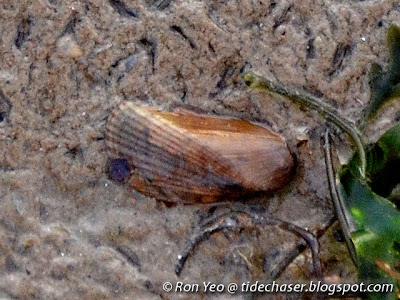
The Asian Date Mussel (Musculista senhousia) is a small brown mussel, usually not more than 3cm long. It is widely collected for food in many countries in the region, and also used to feed fish and poultry.

Most of the time, the Asian Date Mussels are seen forming huge populations, colonising both hard and soft bottoms. They can nest among algae or other colonial mussels by attaching to hard surfaces, or weave their byssal threads into a nest, trapping mud and sediment to form extensive mats covering huge areas with thousands, if not millions, of individuals.

These small black mussels, tentatively identified as Xenostrobus sp., are sometimes seen attached to rocks or colonising pillars of jetties. They seldom exceed 3cm in length.
Family Gryphaeidae
Gryphaeid bivalves are often called "honeycomb oysters" because under a magnifying lens, the shell structure exhibits a honeycomb-like appearance. The shells, often irregularly shaped, can grow to huge sizes of about 30cm, and hence they are sometimes mistaken to be giant clams. Both valves are convex with large, irregular radial ribs, giving the opening on the ventral side a zigzag appearance. The hinge has no tooth. In the shell interior, there is only a large and rounded posterior adductor muscle scar placed closer to the hinge, but no anterior one. The pallial line is present, but the sinus is obscure to absent. They have no siphon. Some species are collect for food.

The Giant Honeycomb Oyster (Hyotissa hyotis) can grow to huge sizes up to 30cm long. It is usually found cemented to hard structures, and can be easily confused with some of the bigger true oyster species. To differentiate them without killing the animal to check for the position of the adductor muscle scar (which is nearer to the hinge), check for areas of the shell that has been chipped, and check for the honeycomb-like shell structure.
Family Ostreidae
Bivalves from the family Ostreidae, also called the "true oysters", are commercially important around the world as food oysters. The shell is hard and often irregularly shaped, and cemented to the substrate by the left valve. The right valve usually appears more flattened, with a protruding fringe beyond the shell margin. The hinge has no tooth, and the shell interior is porcelaneous. It only has the posterior adductor muscle scar, generally, but unlike the previous family it is positioned nearer to the ventral side than to the hinge. It has a pallial line without a sinus, obscure to absent. The animal has no byssus, foot or siphon. Interestingly, both egg-bearing (oviparous) and larvae-bearing (larviparous) species can be found within the family. The larviparous species are able to change sex in the same individual, while the oviparous species may produce either more male or female gametes depending on the nutrients available or environmental temperature.

The Leaf Oyster (Dendostrea folium) is sometimes found attached to mangrove trees, rocks, or even the stem of sea whips. The margin of the shell opening at the ventral side has a wavy or even zigzag appearance, and hence bigger specimens can be mistaken for honeycomb oysters. The colour of the shell exterior can range from yellowish-brown to purplish-brown. They can grow to about 10cm long, and is collected and cultured for food in the region.

The Hooded Oyster (Saccostrea cuccullata) is the commonest true oyster species found in the shallow waters of Singapore, and dense colonies can be seen attached to various hard structures like rocks or roots of mangrove trees. This species is very variable in shape and size. Mature specimens usually have a wavy ventral margin. Some may have a somewhat smooth shell exterior, while others may have obvious radial ribs or concentric layers of plate-like structures.

Younger Hooded Oysters, especially those in more sheltered areas, may have tubular spines rising vertical to the shell. They can attain huge sizes up to 20cm long, but most are around 10cm or smaller.
Family Spondylidae
Commonly called "thorny oysters", spondylid bivalves are more closely related to scallops genetically. The shell is usually stout and very variable in shape, but all are cemented to substrate by the right valve, which is more convex than the left valve. The hinge has two strongly curved teeth and two deep sockets in each valve. The hinge line is straight, and often with a small ear on either side of the umbo. The ligament is mostly internal. The outer surface is usually brightly coloured and marked with numerous thin and spiny or scaly protrusions. The interior of the shell is porcelaneous. Spondylid bivalves have a single, rounded posterior adductor muscle scar, but lacks the anterior muscle scar. The pallial line is present, but without a sinus. The foot is reduced, and the siphon is absent. The adult lacks a byssus. Many species are collected for food.
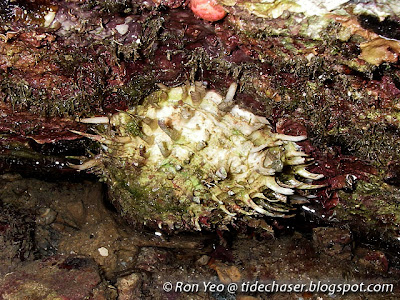
Most Thorny Oysters (Spondylus spp.) are hard to identify on the field, as most species appear very similar.

This Golden Thorny Oyster (Spondylus versicolor) was only identified after it was collected and scrubbed clean. Its left valve has about 20 relatively fine, similar-sized radial ribs which bears thin, sharp spines.

Here is a example of a cleaned thorny oyster (Spondylus sp.) which is part of the Raffles Museum's collection.
References
Here are some of the pteriomorphs that I have photographed and identified on our shores so far (thanks to Siong Kiat who gave tips on how to identify them!). You may want to take a look at the diagram below if you are not familiar with the names of the parts, so as to better understand the terms used.

Family Arcidae
Bivalves from the family Arcidae, usually called arkshells, are characterised by their hooked umbones and straight-edged hinge with a series of small comb-like teeth. The ligament is external, and many have byssal threads to anchor themselves to hard substrates. The shapes tend to appear somewhat rectangular, and the surface is marked with radial ribs and often covered with hair-like structures. In the shell interior, two subequal adductor muscle scars and a pallial line without a sinus can be seen. Interestingly, they have hemoglobin, an oxygen transport pigment, dissolved in both the blood and tissues, colouring the animal reddish. This is unlike most other bivalves, which absorbs oxygen directly from the water into the tissues. In Singapore, they are often mistaken and wrongly identified as cockles, which are from the family Cardiidae, as both families possess radial ribs. The "See Hum" which is well-loved by Singaporeans, either boiled or added to laksa and char kuay teow, is actually an arkshell, but often called "Blood Cockles" in Singapore.

The Antique Arkshell (Anadara antiquata) is usually found on muddy substrates. It has about 35-44 radial ribs that are at most slightly granulated. The shell is greyish white, often stained darker grey around the umbones. It is widely collected for food. It can grow to about 7-10cm long.

The Granular Arkshell (Anadara granosa), also called Blood Cockle or See Hum in Singapore, has thick and solid shells that are strongly inflated.The umbones are large and strongly protruding. It has about 15 to 20 radial ribs which are widely spaced apart on each valve, and the ribs are stout and distinctly marked with somewhat rectangular nodules. It is widely collected for food, and well-loved by Singaporeans, either boiled or added to local dishes such as laksa and char kuay teow. It can grow up to 9cm long, but the ones in the market are usually less than 5cm.

The Almond Arkshell (Barbatia amygdalumtostum) is commonly found under rocks. The shell is dark brown with a few pale bands radiating from the umbones. It generally has a hairy appearance, and can grow to about 5cm long.

I often saw this unknown arkshell during my trips, but unfortunately did not collect it to confirm the species.
Family Pectinidae
Members from the family Pectinidae, or scallops, generally have fan-shaped shells with two fin-like extensions (anterior and posterior ears) at the hinge, one on each side of the "fan", hence forming a straight and extended line at the hinge. The surface is marked with radial ribs. They have a powerful adductor muscle, a toothless hinge with a socket-like arrangement and the ligament is mostly internal. They only have the posterior adductor muscle scar, and have a pallial line but no sinus. Their foot is greatly reduced, and they do not have siphons. To feed, they clap their valves to generate a current so as to filter plankton from the water. Scallops possess tiny but well-developed eyes along the edge of their fleshy mantle. They are able to produce byssus to anchor themselves to hard surfaces, but most species will cast off their byssus as they mature and become free-living. Some species are able to swim by clapping their valves to expel water around the hinge, hence propelling them in the direction of the valve opening. Many scallops are collected for food, and most of the time, only the huge adductor muscle is eaten.

The Singapore Scallop (Volachlamys singaporina) is commonly encountered attached to hard structures (such as another shell) on sandy substrates, especially among seagrass. The shell is relatively small (up to 6 cm long), with 20 to 23 radial ribs on each valve. The anterior ear (on the right in the above photo, but on the left in the below photo) is much longer than the posterior ear.

Sometimes, Singapore Scallops can be found lying freely among seagrasses or on sandy substrates too. The gap between the anterior ear and the main valves, called the byssal notch, is relatively deep.

The Flatribbed Scallop (Comptopallium radula) is commonly found in reef flats, either free-living or attached to hard substrates like rocks and corals. It has about nine to thirteen radial ribs on each valve, with numerous, much smaller, secondary radial riblets. The dorsal ears are somewhat equal-sized. It is collected for food in areas where it is abundant.

A closer look at the opening of the valves of the Flatribbed Scallop reveals lots of short tentacles. The Flatribbed Scallop can grow up to about 9cm.

This Coral Scallop (Coralichlamys madreporarum) is usually found attached to corals, and usually does not exceed a length of 3cm.
Family Limidae
Closely related to the scallops, the file clams of the Limidae family are also fan-shaped, but lacks the fin-like extensions. They only have the posterior adductor muscle scar, and a pallial line but no sinus. The foot can range from short and thick to long and narrow. Most species remain attached to the substrates with byssal threads or hide under rocks, though several are known to be free-living. Some species can swim by clapping their valves, much like the scallops, but instead of moving in the direction of the valve opening, they usually go in the direction of the hinge. They possess long sticky tentacles, which can be vibrantly coloured and break off easily to confuse predators. The shell surface is usually very rough, and hence the common name "file clam".

The Common File Clam (Lima vulgaris) is usually found attached to rocks or corals or as free-living individuals (which can swim actively). The shell is thick and marked with radial sculpture of coarse scaly ribs. It usually does not exceed 9cm in length.

Like most Lima species, the Common File Clam can close its valves completely.

The Fragile File Clam (Limaria fragilis) is usually found under rocks or in crevices, though it can actively swim. The sticky tentacles break off easily to distract predators. Like most other Limaria species, it cannot close its valves completely. The shell can grow to about 5cm long.

This unknown Limaria sp. was seen once under a rock on St John's Island.
Family Pinnidae
Bivalves from the family Pinnidae are usually called pen shells (for their pointed tips) or fan shells (for the shell's fan-like or narrowly triangular shape). The shell is very thin and fragile, the hinge is toothless. The interior of the shell has a thin pearly layer towards the anterior half of the valves. The two adductor muscle scars are unequal, with the anterior one relatively small. There is no pallial sinus. The foot is long, conical and grooved. It has no siphon. These bivalves are usually half-buried in the sand/mud, anchored to their position by numerous byssal threads. The byssal threads of some pen shells are in fact used to weave into sea silk, a very valuable fabric which is extremely light and warm. Species found in the region are often collected for food.

The Bicolor Pen Shell (Pinna bicolor) is often seen embedded in muddy sand and reef flats. They can grow to over 40cm long, and are often collected by locals for food.

Here's a look at the fleshy part of the Bicolor Pen Shell from the top.

Many pen shell (or fan shell) species are covered with sediment or encrusting organisms, and it can be a challenged trying to identify them.
Family Placunidae
Members of this family are often called "window pane shells", as they are collected, polished, and pasted together to make into window panes or lamp shades in the region. The shells are very much flattened, and have a pearly surface. The hinge is almost straight with no teeth and no byssus. The ligament is usually internal, forming an inverted V-shaped structure. The shells have a single, centrally located posterior adductor muscle scar, and no pallial sinus. The foot is long, narrow and cylindrical.

The Windowpane Shell (Placuna placenta) has thin, rounded shells which are almost translucent. It is often found on sandy or sandy-muddy substrates in sheltered coasts without strong waves, sometimes just beneath a thin layer of sand/mud. They are often collected or commercially cultured for their shells, which are used to make window panes and shellcraft. The soft parts are eaten by the locals. It can grow to over 15 cm long.

The Saddle Windowpane Shell (Placuna ephippium) is somewhat rectangular and saddle-shaped, i.e. the shell bends a little, forming a slight arch like the saddle of a horse. It can grow to over 20cm long, and is collected for good and making shellcraft.

Saddle Windowpane Shells can be found in areas with sandy-muddy substrates, and sometimes other sessile organisms can be seen growing attached to it, such as the scallop seen attached to the one above.
Family Anomiidae
Anomiid bivalves, or jingle shells, usually have very thin and somewhat flattened shells. They are usually attached to rocks, shell fragments, or even mangrove trees with their large and calcified byssus. There is a large and deep notch for the byssus in the lower valve near the hinge. The foot is dwarfed, finger-like, and grooved. Most shells have very pretty, pearly surfaces, and are hence collected for shellcraft.

The Mangrove Jingle Shell (Enigmonia aenigmatica) is usually found attached to the leaves of trees in the mangroves, appearing like scales on the leaves.

Sometimes, Mangrove Jingle Shells can also be seen growing on pillars and other man-made structures in the mangroves. Interestingly, while they are usually more yellowish while growing on leaves, they turned purplish brown when they are growing on man-made structures. This animal is known to be motile and move from place to place.

This unidentified jingle shell is attached to a rock fragment.

This is another unidentified jingle shell of a brownish coloration that is attached to the shell of a dead bivalve.
Family Malleidae
Most species from this family are called "hammer oysters", as the shells often appear "T"-shaped, though there are many exceptions. The hinge is narrow and held by an oblique ligament rather than teeth, and the shell is partially nacreous. The umbones are not conspicuous. The interior of each valve only has the posterior adductor muscle scar, and a pallial line without a sinus. The adults may or may not have byssal threads. The foot is divided into two unequal parts. They do not have a siphon. They can be free-living, partially buried in sandy substrates, or attached to hard substrates, or embedded in sponges.

The Sponge Finger Oyster (Vulsella vulsella) is usually found embedded in sponges. It has lost the dorsal ears found in most hammer oyster species. Only the ventral opening protrudes out of the sponge for filter feeding, appearing like fingers poking out. They can grow to over 6cm long.

The White Hammer Oyster (Malleus albus) can be found on sandy or muddy-sandy bottoms, anchored to the substrate by the long and narrow extensions (or ears) of the dorsal margin. It can grow to over 20cm long, and is collect for food in the region.

The Black Hammer Oyster (Malleus malleus) is more commonly found on reef flats and seagrass areas, either attached to hard structures like rocks and dead corals, or living freely, partially buried in the sediment and using the long dorsal ears as an anchor. It is collected for food, and the shell is used to make lime or shellcraft. It can grow to over 20cm long.

The Straight Hammer Oyster (Malleus regula) has very short dorsal ears (mostly only on one side), or none at all. It is normally attached to hard structures on reef flats or rocky shores near mangroves, usually in areas with some sedimentation.

The Straight Hammer Oyster can grow to over 10cm long. It can be easily confused with other similar-looking sessile clams, but can be differentiated by the presence of a beak around the middle of the dorsal margin, and less obvious growth lines.
Family Pteriidae
Bivalves from this family generally have somewhat compressed shells and a straight dorsal margin, with a wing-like ear on each or both ends. Members previously group under the family Isognomonidae (commonly called "leaf oysters") are recently included under this family after phylogenetic studies. The left valve of the shell is usually a little more inflated than the right valve, and there is a strong byssal notch anteriorly. The exterior surface of the shell often appears scaly or lamellate. The umbones are small, and the hinge is narrow and usually toothless. The interior of the shell is usually nacreous, with one large posterior adductor muscle scar and a pallial line but no sinus. The foot is small and grooved, with a strong byssus. They do not have any siphon. Many pearl oysters are from this family, and they have been exploited since ancient times for their ability to produce pearls. Some species may be confused with members of the previous family.

The Pacific Toothed Oyster (Isognomon isognomon) is commonly found in the same area as the Straight Hammer Oyster, and it can be quite a challenge to differentiate them in the field, unless the dorsal margin is not covered by encrusting organisms. They are attached to hard substrates, sometimes in dense colonies. Most have a longer dorsal ear compared to the previous species, and the beak is position more to one side of the dorsal margin. It can be differentiated by the flaky shell exterior composed of layers of plate-like structures as well.

Also, the external ligament is set in a series of transverse grooves along the dorsal margin, giving it the "zebra-crossing" appearance. It can grow to more than 10cm long.

The Mangrove Tree Oyster (Isognomon ephippium) is usually found attached to mangrove trees or rocks near mangroves. It is usually very abundant in areas with muddy brackish water, where dense populations can be found attached to the roots of mangrove trees.

The Mangrove Tree Oyster can grow to about 10cm long, with an irregularly rounded outline. Like other tree oysters, it has a flaky shell exterior, composed of layers of plate-like structures.

Pod Tree Oysters (Isognomon legumen) are commonly found byssally attached to the undersides of rocks in intertidal areas, sometimes forming dense populations. They have whitish shells that are irregularly shaped, but exhibit the same flaky surface with layers of plate-like structures forming the shell exterior.

This unknown tree oyster was found under a rock as well, but the coloration is not typical of Isognomon legumen, so I am not really sure if it is the same species.

Pearl Oysters (Pinctada spp.) can also be found in local waters. They are usually attached to rocks and dead corals.

Winged Oysters (Pteria spp.) are usually seen attached to sea fans or hydroids. The shell exhibit a wing-like appearance. Some species are known to produce pearls.
Family Mytilidae
Members of this family are usually called "mussels". They generally have pear-shaped shells, and are attached to the substrates with strong byssus. Most are found on rocky and other hard substrates, but some have adapted to living in sandy or muddy substrates as well, with some species building nest covering huge areas of shallow sea beds. The hinge has no or reduced teeth, and the ligament is long and external. The interior of the shell is pearly. The anterior adductor muscle scar is small or sometimes absent in the adult, while the posterior adductor scar is large. The shell has a pallial line but no sinus. The foot is long and grooved. The siphons are either very reduced or absent. Many species are economically important, being edible and abundant.

Asian Green Mussels (Perna viridis) are very commonly in local waters, usually found attached to jetties and rocks in shallow waters. The shell is usually green and brown in colour, and trigonal-ovate in shape.

They are attached to the rocks and other hard substrates with byssus. Bigger ones can grow to more than 10cm long. They are commercially very important in the region, and are widely cultivated for food.

Juvenile Asian Green Mussels are more bluish in colour.

The Box Mussel (Septifer bilocularis) is a much smaller species, often not more than 4cm long. They are commonly found attached to rocks and corals, usually on the underside. The shell exterior is densely covered with fine radial lines, though some may be covered with encrusting organisms. Bigger ones are collected for food in the region, or for shellcraft.

The Philippine Brown Mussel (Modiolus philippinarum), also called the Phillippine Horse Mussel, is somewhat trapezoidal in shape, and as the name implies, brown in colour. It can grow to about 10cm long, and occurs on muddy and gravely mud flats or muddy-sandy substrates.

Here's a posterior view of the same mussel.

The Asian Date Mussel (Musculista senhousia) is a small brown mussel, usually not more than 3cm long. It is widely collected for food in many countries in the region, and also used to feed fish and poultry.

Most of the time, the Asian Date Mussels are seen forming huge populations, colonising both hard and soft bottoms. They can nest among algae or other colonial mussels by attaching to hard surfaces, or weave their byssal threads into a nest, trapping mud and sediment to form extensive mats covering huge areas with thousands, if not millions, of individuals.

These small black mussels, tentatively identified as Xenostrobus sp., are sometimes seen attached to rocks or colonising pillars of jetties. They seldom exceed 3cm in length.
Family Gryphaeidae
Gryphaeid bivalves are often called "honeycomb oysters" because under a magnifying lens, the shell structure exhibits a honeycomb-like appearance. The shells, often irregularly shaped, can grow to huge sizes of about 30cm, and hence they are sometimes mistaken to be giant clams. Both valves are convex with large, irregular radial ribs, giving the opening on the ventral side a zigzag appearance. The hinge has no tooth. In the shell interior, there is only a large and rounded posterior adductor muscle scar placed closer to the hinge, but no anterior one. The pallial line is present, but the sinus is obscure to absent. They have no siphon. Some species are collect for food.

The Giant Honeycomb Oyster (Hyotissa hyotis) can grow to huge sizes up to 30cm long. It is usually found cemented to hard structures, and can be easily confused with some of the bigger true oyster species. To differentiate them without killing the animal to check for the position of the adductor muscle scar (which is nearer to the hinge), check for areas of the shell that has been chipped, and check for the honeycomb-like shell structure.
Family Ostreidae
Bivalves from the family Ostreidae, also called the "true oysters", are commercially important around the world as food oysters. The shell is hard and often irregularly shaped, and cemented to the substrate by the left valve. The right valve usually appears more flattened, with a protruding fringe beyond the shell margin. The hinge has no tooth, and the shell interior is porcelaneous. It only has the posterior adductor muscle scar, generally, but unlike the previous family it is positioned nearer to the ventral side than to the hinge. It has a pallial line without a sinus, obscure to absent. The animal has no byssus, foot or siphon. Interestingly, both egg-bearing (oviparous) and larvae-bearing (larviparous) species can be found within the family. The larviparous species are able to change sex in the same individual, while the oviparous species may produce either more male or female gametes depending on the nutrients available or environmental temperature.

The Leaf Oyster (Dendostrea folium) is sometimes found attached to mangrove trees, rocks, or even the stem of sea whips. The margin of the shell opening at the ventral side has a wavy or even zigzag appearance, and hence bigger specimens can be mistaken for honeycomb oysters. The colour of the shell exterior can range from yellowish-brown to purplish-brown. They can grow to about 10cm long, and is collected and cultured for food in the region.

The Hooded Oyster (Saccostrea cuccullata) is the commonest true oyster species found in the shallow waters of Singapore, and dense colonies can be seen attached to various hard structures like rocks or roots of mangrove trees. This species is very variable in shape and size. Mature specimens usually have a wavy ventral margin. Some may have a somewhat smooth shell exterior, while others may have obvious radial ribs or concentric layers of plate-like structures.

Younger Hooded Oysters, especially those in more sheltered areas, may have tubular spines rising vertical to the shell. They can attain huge sizes up to 20cm long, but most are around 10cm or smaller.
Family Spondylidae
Commonly called "thorny oysters", spondylid bivalves are more closely related to scallops genetically. The shell is usually stout and very variable in shape, but all are cemented to substrate by the right valve, which is more convex than the left valve. The hinge has two strongly curved teeth and two deep sockets in each valve. The hinge line is straight, and often with a small ear on either side of the umbo. The ligament is mostly internal. The outer surface is usually brightly coloured and marked with numerous thin and spiny or scaly protrusions. The interior of the shell is porcelaneous. Spondylid bivalves have a single, rounded posterior adductor muscle scar, but lacks the anterior muscle scar. The pallial line is present, but without a sinus. The foot is reduced, and the siphon is absent. The adult lacks a byssus. Many species are collected for food.

Most Thorny Oysters (Spondylus spp.) are hard to identify on the field, as most species appear very similar.

This Golden Thorny Oyster (Spondylus versicolor) was only identified after it was collected and scrubbed clean. Its left valve has about 20 relatively fine, similar-sized radial ribs which bears thin, sharp spines.

Here is a example of a cleaned thorny oyster (Spondylus sp.) which is part of the Raffles Museum's collection.
References
- Abbott, R. T., 1991. Seashells of Southeast Asia. Graham Brash, Singapore. 145 pp.
- Bunje, P. 2001. The bivalvia. University of California Museum of Paleontology. Retrieved Nov 14, 2012, from http://www.ucmp.berkeley.edu/taxa/inverts/mollusca/bivalvia.php.
- Carpenter, K. E. & V. H. Niem (eds), 1998-2001. FAO species identification guide for fishery purposes. The living marine resources of the Western Central Pacific. Volumes 1 to 6. FAO, Rome. pp. 1-4218.
- Carter, J. G. et al. 2011. A synoptical classification of the bivalvia (mollusca). Paleontological Contributions 4: 1‑47.
- Cox, L. R., N. D. Newell et al. 1969. Treatise on Invertebrate Paleontology: Part N. Mollusca 6. Bivalvia, Volume 2. The Geological Society of America, Inc. and The University of Kansas.
- Gladys Archerd Shell Collection at Washington State University Tri-Cities Natural History Museum. 2008. Retrieved November 15, 2012, from http://shells.tricity.wsu.edu/ArcherdShellCollection/ShellCollection.html.
- Lam, K. and B. Morton. 2004. The oysters of Hong Kong (Bivalvia: Ostreidae and Gryphaeidae). The Raffles Bulletin of Zoology 52(1):11-28.
- Oliver, A. P. H., 2012. Philip's guide to seashells of the world. Philip's, London. 400 pp.
- Rogers, J. E., 1908. The Shell Book - A Popular Guide to a Knowledge of the Families of Living Molluscs, and an Aid to the identification of Shells Native and Foreign. Charles T. Branford Co., Publishers. Boston, Massachusetts. 485 pp.
- Tan, K. S. & L. M. Chou, 2000. A guide to common seashells of Singapore. Singapore Science Centre, Singapore. 168 pp.
- Tan, S. K. & H. P. M. Woo, 2010. A preliminary checklist of the molluscs of Singapore. Raffles Museum of Biodiversity Research, National University of Singapore, Singapore. 78 pp. Uploaded 02 June 2010.
- Tan, S. K. & R. K. H. Yeo, 2010. The intertidal molluscs of Pulau Semakau: preliminary results of “Project Semakau". Nature in Singapore, 3: 287–296.
- Wong, H. W., 2009. The Mactridae of East Coast Park, Singapore. Nature in Singapore, 2: 283–296.
- World Register of Marine Species. 2012. Retrieved Nov 14, 2012, from http://www.marinespecies.org.

1 comment:
me gustó tu artículo, gracias :)
Post a Comment